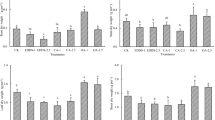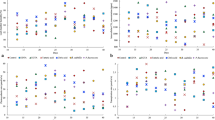Abstract
Toxic contaminants (metals and metal-containing compounds) are accumulating in the environment at an astonishing rate and jeopardize human health. Remarkable industrial revolution and the spectacular economic growth are the prime causes for the release of such toxic contaminants in the environment. Cadmium (Cd) is ranked the 7th most toxic compound by the Agency for Toxic Substances and Disease Registry (USA), owing to its high carcinogenicity and non-biodegradability even at miniscule concentration. The present study assessed the efficiency of four biodegradable chelants [nitrilotriacetic acid (NTA), ethylenediamine disuccinate (EDDS), ethylene glycol tetraacetic acid (EGTA), and citric acid (CA)] and their dose (5 mM and 10 mM) in enhancing metal accumulation in Solanum americanum Mill. (grown under 24 mg Cd kg−1 soil) through morpho-physiological and metal extraction parameters. Significant variations were observed for most of the studied parameters in response to chelants and their doses. However, ratio of root and shoot length, and plant height stress tolerance index differed non-significantly. The potential of chelants to enhance Cd removal efficiency was in the order — EGTA (7.44%) > EDDS (6.05%) > NTA (4.12%) > CA (2.75%). EGTA and EDDS exhibited dose-dependent behavior for Cd extraction with 10 mM dose being more efficient than 5 mM dose. Structural equation model (SEM) depicted strong positive interaction of metal extraction parameters with chelants (Z-value = 11.61, p = 0.001). This study provides insights into the importance of selecting appropriate dose of biodegradable chelants for Cd extraction, as high chelant concentration might also result in phytotoxicity. In the future, phytoextraction potential of these chelants needs to be examined through field studies under natural environmental conditions.



Similar content being viewed by others
Data availability
The datasets used and/or analyzed during the current study are available from the corresponding author on reasonable request.
References
Agathokleous E, Belz RG, Kitao M, Koike T, Calabrese EJ (2019) Does the root to shoot ratio show a hormetic response to stress? An ecological and environmental perspective. J For Res 30:1569–1580. https://doi.org/10.1007/s11676-018-0863-7
Ali H, Khan E, Ilahi I (2019) Environmental chemistry and ecotoxicology of hazardous heavy metals: environmental persistence, toxicity, and bioaccumulation. J Chem 2019:6730305. https://doi.org/10.1155/2019/6730305
ATSDR (2019) Priority list of hazardous substances. Agency for Toxic Substances and Diseases. http://www.atsdr.cdc.gov/SPL/index.html
Beiyuan J, Fang L, Chen H, Li M, Liu D, Wang Y (2021) Nitrogen of EDDS enhanced removal of potentially toxic elements and attenuated their oxidative stress in a phytoextraction process. Environ Pollut 268:115719. https://doi.org/10.1016/j.envpol.2020.115719
Bernardino CAR, Mahler CF, Alvarenga P, Castro PML, da Silva EF, Novo LAB (2020) Recent advances in phytoremediation of soil contaminated by industrial waste: a road map to a safer environment. In: Saxena G, Bharagava R (eds) Bioremediation of industrial waste for environmental safety. Springer, Singapore. https://doi.org/10.1007/978-981-13-1891-7_10
Chen X, Zhao Y, Zeng C, Li Y, Zhu L, Wu J, Chen J, Wei Z (2019) Assessment contributions of physicochemical properties and bacterial community to mitigate the bioavailability of heavy metals during composting based on structural equation models. Bioresour Technol 289:121657. https://doi.org/10.1016/j.biortech.2019.121657
Chen L, Yang J-Y, Wang D (2020) Phytoremediation of uranium and cadmium contaminated soils by sunflower (Helianthus annuus L.) enhanced with biodegradable chelating agents. J Clean Prod 263:121491–121500. https://doi.org/10.1016/j.jclepro.2020.121491
Coakley S, Cahill G, Enright AM, O’Rourke B, Petti C (2019) Cadmium hyperaccumulation and translocation in Impatiens glandulifera: from foe to friend? Sustainability 11:5018. https://doi.org/10.3390/su11185018
Diarra I, Kotra KK, Prasad S (2021) Assessment of biodegradable chelating agents in the phytoextraction of heavy metals from multi–metal contaminated soil. Chemosphere 273:128483. https://doi.org/10.1016/j.chemosphere.2020.128483
do Nascimento CWA, Amarasiriwardena D, Xing B (2006) Comparison of natural organic acids and synthetic chelates at enhancing phytoextraction of metals from a multi-metal contaminated soil. Environ Pollut 140:114–123https://doi.org/10.1016/j.envpol.2005.06.017
Doumett S, Lamperi L, Checchini L, Azzarello E, Mugnai S, Mancuso S, Petruzzelli G, Del Bubba M (2008) Heavy metal distribution between contaminated soil and Paulownia tomentosa, in a pilot-scale assisted phytoremediation study: influence of different complexing agents. Chemosphere 72:1481–1490. https://doi.org/10.1016/j.chemosphere.2008.04.083
Du J, Zhang B, Li J, Lai B (2020) Decontamination of heavy metal complexes by advanced oxidation processes: a review. Chin Chem Lett 31:2575–2582. https://doi.org/10.1016/j.cclet.2020.07.050
Ghosh M, Singh SP (2005) A comparative study of cadmium phytoextraction by accumulator and weed species. Environ Pollut 133:365–371. https://doi.org/10.1016/j.envpol.2004.05.015
Goswami S, Das S (2015) A study on cadmium phytoremediation potential of Indian mustard, Brassica juncea. Int J Phytoremed 17:583–588. https://doi.org/10.1080/15226514.2014.935289
Guo D, Ali A, Ren C, Du J, Li R, Lahori AH, Xiao R, Zhang Z, Zhang Z (2019) EDTA and organic acids assisted phytoextraction of Cd and Zn from a smelter contaminated soil by potherb mustard (Brassica juncea, Coss) and evaluation of its bioindicators. Ecotoxicol Environ Saf 167:396–403. https://doi.org/10.1016/j.ecoenv.2018.10.038
Haider FU, Liqun C, Coulter JA, Cheema SA, Wu J, Zhang R, Wenjun M, Farooq M (2021) Cadmium toxicity in plants: impacts and remediation strategies. Ecotoxicol Environ Saf 211:111887. https://doi.org/10.1016/j.ecoenv.2020.111887
Kazemi EM, Kolahi M, Yazdi M, Goldson-Barnaby A (2020) Anatomic features, tolerance index, secondary metabolites and protein content of chickpea (Cicer arietinum) seedlings under cadmium induction and identification of PCS and FC genes. Physiol Mol Biol Plants 26:1551–1568. https://doi.org/10.1007/s12298-020-00804-3
Lan J, Zhang S, Lin H, Li T, Xu X, Li Y, Jia Y, Gong G (2013) Efficiency of biodegradable EDDS, NTA and APAM on enhancing the phytoextraction of cadmium by Siegesbeckia orientalis L. grown in Cd-contaminated soils. Chemosphere 91:1362–1367. https://doi.org/10.1016/j.chemosphere.2013.01.116
Li Y, He N, Hou J, Xu L, Liu C, Zhang J, Wang Q, Zhang X, Wu X (2018) Factors influencing leaf chlorophyll content in natural forests at the biome scale. Front Ecol Evol 6:64. https://doi.org/10.3389/fevo.2018.00064
Lu H, Qiao D, Han Y, Zhao Y, Bai F, Wang Y (2021) Low molecular weight organic acids increase Cd accumulation in sunflowers through increasing Cd bioavailability and reducing Cd toxicity to plants. Minerals 11:243. https://doi.org/10.3390/min11030243
Luo J, Cai L, Qi S, Wu J, Gu XWS (2017) Improvement effects of cytokinin on EDTA assisted phytoremediation and the associated environmental risks. Chemosphere 185:386–393. https://doi.org/10.1016/j.chemosphere.2017.07.036
Luo J, Cai L, Qi S, Wu J, Gu XS (2018) Influence of direct and alternating current electric fields on efficiency promotion and leaching risk alleviation of chelator assisted phytoremediation. Ecotoxicol Environ Saf 149:241–247. https://doi.org/10.1016/j.ecoenv.2017.12.005
Mahajan P, Sharma P, Singh HP, Rathee S, Sharma M, Batish DR, Kohli RK (2021) Amelioration potential of β-pinene on Cr(VI)-induced toxicity on morphology, physiology and ultrastructure of maize. Environ Sci Pollut Res 28:62431–62443. https://doi.org/10.1007/s11356-021-15018-7
Morrison PWJ, Khutoryanskiy VV (2014) Enhancement in corneal permeability of riboflavin using calcium sequestering compounds. Int J Pharm 472:56–64. https://doi.org/10.1016/j.ijpharm.2014.06.007
Olaifa FE, Olaifa AK, Adelaja AA, Owolabi AG (2004) Heavy metal contamination of Clarias gariepinus from a lake and fish farm in Ibadan, Nigeria. Afr J Biomed Res 7:145–148. https://doi.org/10.4314/ajbr.v7i3.54185
Rahimzadeh MR, Rahimzadeh MR, Kazemi S, Moghadamnia AA (2017) Cadmium toxicity and treatment: an update. Caspian J Intern Med 8:135–145. https://doi.org/10.22088/cjim.8.3.135
Ren M, Qin Z, Li X, Wang L, Wang Y, Zhang J, Huang Y, Yang S (2020) Selenite antagonizes the phytotoxicity of Cd in the cattail Typha angustifolia. Ecotox Environ Saf 189:109959. https://doi.org/10.1016/j.ecoenv.2019.109959
Sharma P, Ahmad M, Rathee S, Singh HP, Batish DR, Kohli RK (2021) Bridging the gap: linking morpho-functional traits’ plasticity with hyperaccumulation. Environ Monit Asses 193:762. https://doi.org/10.1007/s10661-021-09504-1
Tahmasbian I, Sinegani AAS (2016) Improving the efficiency of phytoremediation using electrically charged plant and chelating agents. Environ Sci Pollut Res 23:2479–2486. https://doi.org/10.1007/s11356-015-5467-6
Vasudevan S, Lakshmi J, Sozhan G (2011) Effects of alternating and direct current in electrocoagulation process on the removal of cadmium from water. J Hazard Mater 192:26–34. https://doi.org/10.1016/j.jhazmat.2011.04.081
Wang K, Liu Y, Song Z, Wang D, Qiu W (2019) Chelator complexes enhanced Amaranthus hypochondriacus L. phytoremediation efficiency in Cd-contaminated soils. Chemosphere 237:124480–124488. https://doi.org/10.1016/j.chemosphere.2019.124480
Wang Y, Xu Y, Qin X, Zhao L, Huang Q, Liang X (2021) Effects of S, S-ethylenediamine disuccinic acid on the phytoextraction efficiency of Solanum nigrum L. and soil quality in Cd-contaminated alkaline wheat soil. Environ Sci Pollut Res 28:42959–42974. https://doi.org/10.1007/s11356-021-13764-2
Wei S, Zhou Q, Wang X, Zhang K, Guo G, Ma LQ (2005) A newly-discovered Cd-hyperaccumulator Solatium nigrum L. Chin Sci Bull 50:33–38. https://doi.org/10.1360/982004-292
Wei L, Luo C, Wang C, Li X, Shen Z (2007) Biodegradable chelating agent ethylenediaminedisuccinic acid reduces uptake of copper through alleviation of copper toxicity in hydroponically grown Chrysanthemum coronarium L. Environ Toxicol Chem 26:749–754. https://doi.org/10.1897/06-409R1.1
Xu Y, Yamaji N, Shen RF, Ma JF (2007) Sorghum roots are inefficient in uptake of EDTA-chelated lead. Ann Bot 99:869–875. https://doi.org/10.1093/aob/mcm038
Yang W, Dai H, Skuza L, Wei S (2019) Strengthening role and the mechanism of optimum nitrogen addition in relation to Solanum nigrum L. Cd hyperaccumulation in soil. Ecotoxicol Environ Saf 182:109444. https://doi.org/10.1016/j.ecoenv.2019.109444
Zhang S, Chen M, Li T, Xu X, Deng L (2010) A newly found cadmium accumulator—Malva sinensis Cavan. J Hazard Mater 173:705–709. https://doi.org/10.1016/j.jhazmat.2009.08.142
Author information
Authors and Affiliations
Contributions
HPS and DRB: Project leader, experimental layout, manuscript preparation; PS: Establishment and execution of experiment, data collection and analysis; SR: Data collection, data analysis, manuscript preparation; MA: Data analysis and modeling; HPS, DRB and RKK: Manuscript editing. All the authors contributed to the final draft of the manuscript.
Corresponding author
Ethics declarations
Ethics approval and consent to participate
Not applicable.
Consent for publication
Not applicable.
Competing interests
The authors declare that they have no competing interests.
Additional information
Responsible Editor: Elena Maestri
Publisher's note
Springer Nature remains neutral with regard to jurisdictional claims in published maps and institutional affiliations.
Rights and permissions
About this article
Cite this article
Sharma, P., Rathee, S., Ahmad, M. et al. Biodegradable chelant-metal complexes enhance cadmium phytoextraction efficiency of Solanum americanum. Environ Sci Pollut Res 29, 57102–57111 (2022). https://doi.org/10.1007/s11356-022-19622-z
Received:
Accepted:
Published:
Issue Date:
DOI: https://doi.org/10.1007/s11356-022-19622-z




